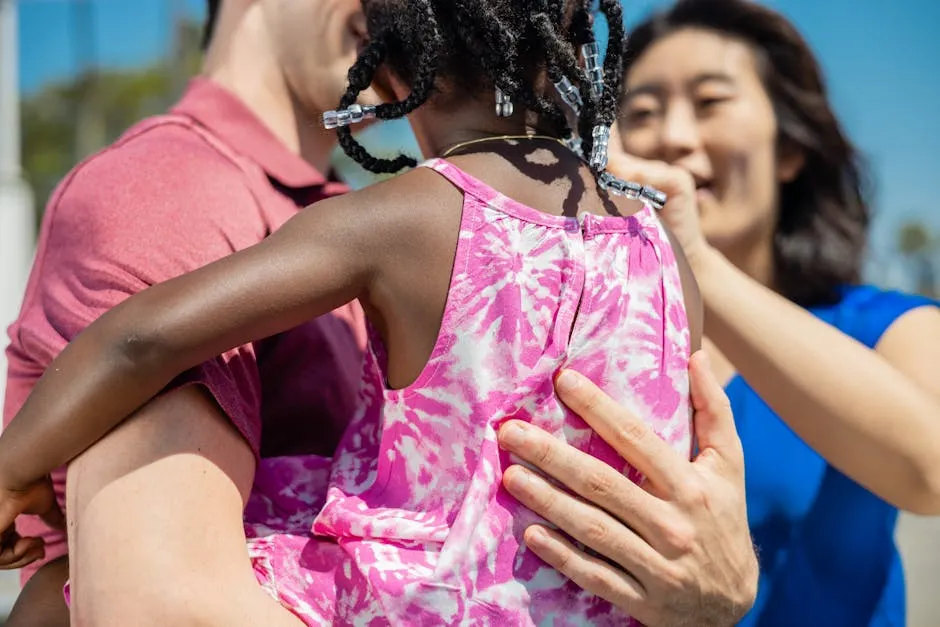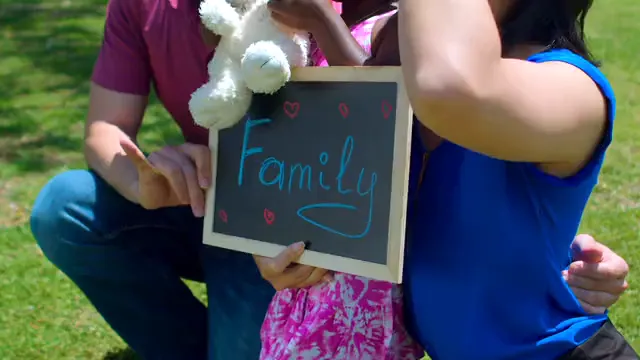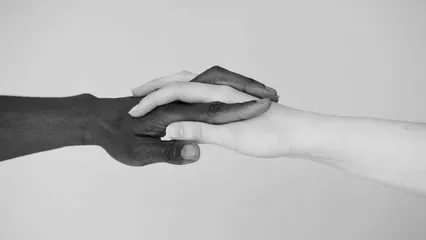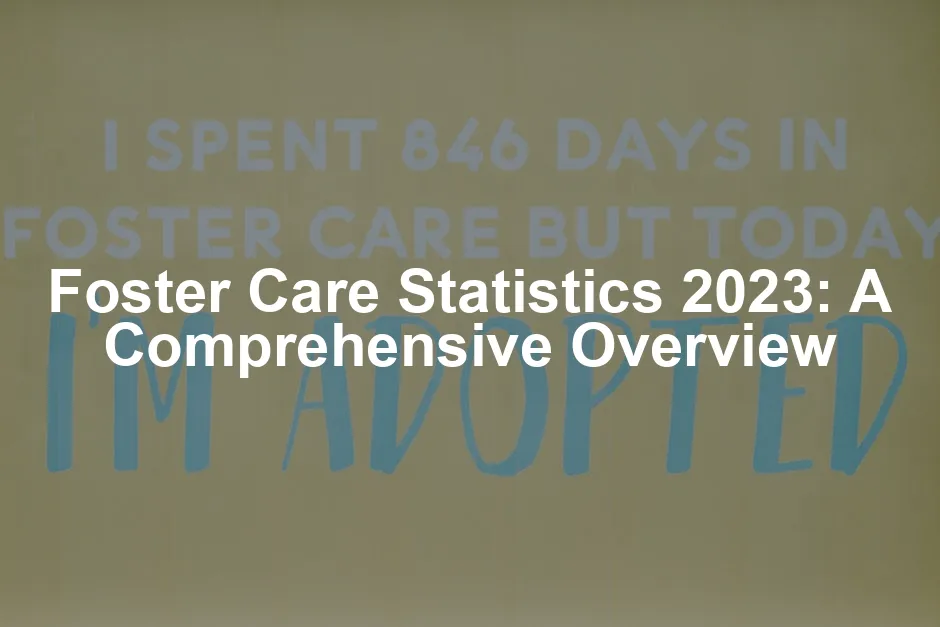Introduction
Understanding foster care statistics is crucial. These statistics shine a light on the lives of vulnerable children. They inform policies and community support, ensuring kids receive the help they deserve. In 2023, the foster care landscape is both challenging and enlightening.
Currently, over 390,000 children are in foster care in the United States. This number reflects a system grappling with numerous issues, from family instability to societal factors. The statistics reveal trends, gaps, and areas requiring urgent attention.
In this article, we’ll cover essential statistics about the number of children in foster care, including state-by-state breakdowns and demographic insights. We encourage you to engage with this information, spreading awareness and considering how you can contribute to improving the foster care system. Together, we can make a difference in the lives of these children.

I. Number of Children in Foster Care
A. Current Statistics
As of 2023, an estimated 355,032 children are in foster care across the U.S. This marks a 7% decrease from previous years. The number of children in care reached a high of 437,000 in 2018, indicating fluctuations in the system. This decrease stems from efforts to provide support to families, preventing children from entering foster care.
Data from the Adoption and Foster Care Analysis and Reporting System (AFCARS) shows that most children in foster care are aged between 1 and 5 years, making up 29% of those entering care. In contrast, only 7% are infants. The gender distribution is nearly equal, with 51% male and 49% female.

B. State-by-State Breakdown
Certain states report higher numbers of children in foster care. California leads with 45,924 children, followed by Florida with 22,493 and Texas with 21,358. These states face unique challenges contributing to higher placements.
When analyzing population ratios, West Virginia takes the lead, with 19.8 children in foster care per 1,000. In contrast, New Jersey has only 1.6 per 1,000. This stark difference points to varying state policies and socio-economic factors influencing foster care needs.
The statistics indicate an urgent need for more foster families. As the number of children in care fluctuates, communities must rally together to provide safe and loving homes. By spreading awareness and engaging with local foster care initiatives, we can help change the narrative for these children.

C. Demographics
In the foster care system, children come from diverse backgrounds. The ethnic representation reveals significant disparities. For instance, while 43% of children are White, 22% are Black or African American, and 22% are Hispanic. Understanding these demographics is vital for tailoring support services.
The average age of children in foster care is around 8 years old, with most under 10. Statistics show that 27% are teenagers, highlighting the need for targeted resources for older youth transitioning out of care.
As we explore these statistics, it becomes clear that understanding the current landscape of foster care is essential. With this knowledge, we can advocate for children and families in need, ensuring they receive the support and stability they deserve.

C. Demographics
Age and Gender Breakdown
The foster care system hosts a diverse population of children. Understanding their age and gender distribution is crucial for tailoring support programs. As of 2023, the average age of children in foster care is around 8 years old, with a significant proportion being younger. Specifically, 29% of children entering care are aged 1 to 5 years, while only 7% are infants.
In terms of gender, the distribution is almost balanced. 51% of children in foster care are male, while 49% are female. This near-equal representation indicates that support systems need to be equally effective for both genders, catering to their unique needs.
To visualize this data, consider the following chart:
| Age Group | Percentage |
|---|---|
| Infants (0-1) | 7% |
| Toddlers (1-5) | 29% |
| Children (6-12) | 37% |
| Teens (13-17) | 27% |
This breakdown illustrates the urgency for age-appropriate resources, particularly for younger children who may require more intensive developmental support.
Racial and Ethnic Composition
The racial and ethnic diversity within the foster care system is striking. In 2023, 43% of foster children are White, while 22% are Black or African American, and another 22% identify as Hispanic. The statistics reveal significant disparities that need addressing. For example, Black children are overrepresented in the foster care system, entering care at rates much higher than their White counterparts.
| Racial/Ethnic Group | Percentage |
|---|---|
| White | 43% |
| Black/African American | 22% |
| Hispanic | 22% |
| Other | 13% |
These demographics suggest a pressing need for targeted interventions. Programs that acknowledge cultural backgrounds can enhance placement stability and improve outcomes for children in care. Understanding the racial and ethnic composition is essential for developing policies that promote equity and justice within the foster care system.
In summary, the demographics of children in foster care reveal critical insights. The balance in gender calls for equally effective support systems, while the age distribution emphasizes the need for age-appropriate resources. The racial and ethnic composition indicates areas for improvement, advocating for culturally competent approaches to care. Understanding these statistics is vital for shaping the future of foster care and ensuring that all children receive the support they deserve.

B. Factors Influencing Length of Stay
In the ever-evolving world of foster care, understanding the factors influencing children’s length of stay is essential. Two significant paths emerge: reunification with biological families and adoption. Each path comes with its own statistics and implications.
If you’re looking for insights into how to navigate the complex emotional landscape of adoption, consider reading “The Connected Child: Bring Hope and Healing to Your Adoptive Family” by Karyn B. Purvis. This book is a treasure trove of strategies to foster connection and healing in adoptive families.

Reunification vs. Adoption
Reunification remains a primary goal for many children in foster care. As of 2022, approximately 46% of children exiting foster care returned to their families. This statistic highlights the system’s dedication to keeping families together whenever possible. Reunification tends to be a shorter path, with many children spending less time in care. The average stay for those who reunify is typically about 22 months.
However, adoption plays a crucial role in providing permanent homes for children who cannot return to their biological families. In 2022, 27% of exits from the foster care system were due to adoption, which translates to around 52,985 children finding forever families. This marks a significant commitment to securing stable futures for vulnerable youth.
If you’re curious about the emotional journey of children in foster care, you might find “The Primal Wound: Understanding the Adopted Child” by Nancy Verrier to be an eye-opening read.
When comparing the two paths, it becomes clear that reunification is more common, yet adoption is vital for those needing permanent placements. The journey each child takes can vary greatly based on individual circumstances, including family dynamics, the nature of the cases, and available support services.
While reunification serves as a beacon of hope, it’s essential to recognize that not every situation allows for a return home. For those who cannot reunite, adoption offers a chance to break the cycle of instability. Understanding the balance between these two paths is crucial in shaping policies and practices that prioritize children’s well-being.
As we reflect on the statistics, we see that the foster care system’s effectiveness hinges on providing the right resources and support for families. This ensures children can either reunify or transition into loving adoptive homes, ultimately fostering a more stable environment for their growth and development.

B. Systemic Challenges
Overrepresentation of Certain Groups
The foster care system reflects deep-rooted societal issues, particularly affecting racial and ethnic minorities. For instance, while Black children make up only 14% of the overall child population, they represent about 20% of those entering foster care. The statistics reveal that the odds are stacked against children of color, with Black children facing a 1 in 9 chance of entering foster care compared to 1 in 17 for their White counterparts.
This disparity stems from systemic factors, including poverty, family instability, and unequal access to resources. Many families of color encounter challenges that lead to higher rates of intervention from child protective services, often resulting in foster care placements. Addressing this overrepresentation requires a commitment to understanding and dismantling these systemic barriers, ensuring every child has a fair opportunity to thrive.

For those looking to understand the psychological effects of trauma, Bessel van der Kolk’s “The Body Keeps the Score: Brain, Mind, and Body in the Healing of Trauma” is a must-read that delves into how trauma affects the body and mind.
Trauma and Resilience
Children in foster care often grapple with trauma that shapes their experiences and outcomes. The statistics indicate that between 50% and 80% of these children meet the criteria for mental health disorders. However, they also show remarkable resilience. Research indicates that many foster children display comparable levels of resilience to their peers facing similar adversities outside the system.
For instance, studies reveal that despite the challenges they face, foster youth often exhibit strong coping abilities and adaptability. This resilience is crucial, as it impacts their emotional and psychological well-being in the long run. By focusing on building supportive environments and providing therapeutic resources, we can further enhance the ability of these children to overcome their challenges and lead fulfilling lives.
If you want to empower children in your life, consider the “Raising the Trauma-Resilient Child: A Practical Guide” by J. D. Smith. This guide offers practical strategies for fostering resilience in children facing adversity.
When we look at the broader picture, it becomes essential to address both the systemic challenges and the innate strengths of children in foster care. By doing so, we can foster a more equitable system that not only supports the needs of vulnerable youth but also champions their resilience and potential.

Final Thoughts
Understanding foster care statistics is essential for fostering advocacy and informed community support. The realities behind these numbers paint a vivid picture of the challenges faced by children in foster care. Knowing the statistics helps us comprehend the ongoing struggles and triumphs within the system, enabling us to better support these vulnerable children.
Statistics like the estimated 355,032 children currently in foster care underscore the pressing need for more foster families. Each number represents a child with unique experiences, dreams, and potential. When we grasp the significance of these statistics, we can advocate for necessary changes.

Community engagement is crucial. By sharing information, we can rally support for local foster care initiatives and encourage others to become foster parents. Every action counts, whether volunteering, donating, or simply spreading awareness.
Moreover, understanding the demographics of children in foster care can inform tailored support services. For instance, recognizing that a significant percentage of children are teenagers can lead to targeted programs addressing their specific needs. Foster care statistics 2023 provide deeper insights into these demographics.
Understanding the current landscape of foster care statistics is vital for advocating for necessary changes in the system. Foster care statistics 2023 provide essential insights into the demographics and needs of children in care.
So, let’s not just glance at these figures; let’s dive deeper. Let’s use foster care statistics to spark conversations and drive change. Together, we can create a supportive environment where every child feels valued and has the opportunity to thrive.
Now, more than ever, it’s vital to engage with these statistics. They are more than numbers; they are a call to action. Let’s rise to the occasion and champion the cause of foster care, ensuring that every child has a safe and loving home.
FAQs
What are the age limits for foster care?
Foster care typically serves children from birth until they reach the age of majority, usually 18 years old. Some states allow for extended support until 21 years old. The goal is to provide stability and care for children during critical developmental years.
How can someone become a foster parent?
Becoming a foster parent involves several steps. First, research local agencies or organizations that provide foster care services. Next, complete the application process, which often includes background checks, interviews, and home assessments. Training sessions may also be required to prepare you for the responsibilities of fostering.
What resources are available for foster families?
Foster families can access various resources, including training programs, support groups, and financial assistance. Local child welfare agencies often provide these resources, along with guidance on navigating the foster care system. Websites like the National Foster Parent Association offer additional support and information.
How does the foster care system differ by state?
Foster care systems can vary significantly by state due to differing laws, funding, and policies. Some states may have more robust support systems, while others may experience higher rates of children in care. Researching your specific state can provide insights into local practices and resources.
What are the legal rights of children in foster care?
Children in foster care have several legal rights aimed at ensuring their safety and well-being. These include the right to be treated with respect, the right to participate in decisions affecting their lives, and the right to receive appropriate health care and education. Additionally, they have the right to maintain contact with siblings and other family members, where possible.
If you are interested in some educational resources for children, check out the LEGO Classic Large Creative Brick Box or the Melissa & Doug Wooden Building Blocks Set. These toys can help foster creativity and development in young children!
Please let us know what you think about our content by leaving a comment down below!
Thank you for reading till here 🙂
All images from Pexels




